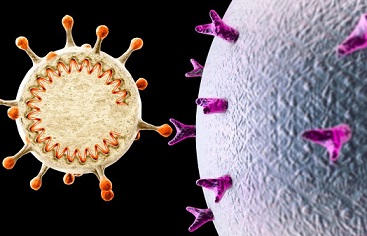BREAKING NEWS! Chinese Scientist Raises Alarm On Newly Emerging Omicron Sublineages' Alarming Trend Of Escalating Cellular Infectivity
COVID-19 News - Omicron Sublineages' Alarming Trend Of Escalating Cellular Infectivity May 26, 2023 1 year, 10 months, 3 weeks, 4 days, 14 hours, 37 minutes ago
COVID-19 News: In a shocking revelation that has sent shockwaves through the scientific community, a group of Chinese scientists has issued a grave warning about the newly-emerged sub-lineages of the Omicron variant. These sub-lineages, according to their findings, display a deeply troubling and dangerous characteristic: an unprecedented increase in cellular infectivity.

Since the outbreak of the COVID-19 pandemic, the world has witnessed the emergence of various SARS-CoV-2 variants. However, the Omicron variant, also known as B.1.1.529, has taken the global stage by storm, rapidly surpassing its predecessor, the Delta variant. Adding to the concern, the Omicron variant has continued to mutate, giving rise to multiple sub-lineages that have evolved to adapt to the human host as covered in many previous studies and
COVID-19 News reports.
With mounting urgency, the Chinese Academy of Medical Sciences, in collaboration with Peking Union Medical College and Suzhou Hospital-Affiliated Hospital of Medical School, Nanjing University, embarked on an extensive investigation into the infectivity, proteolytic activation, viral entry pathways, membrane fusion, and sensitivity to antibody neutralization of these predominant Omicron sub-lineages.
The researchers found alarming mutations in the spike (S) proteins of the Omicron sub-lineages, particularly within the receptor binding domain (RBD). These mutations have the potential to alter the conformation of the S protein, affecting its interaction with receptors and neutralizing antibodies. Utilizing a sophisticated pseudovirus system, the scientists discovered that certain sub-lineages, such as BA.2.12.1, BA.2 + L452Q, BA.4/5, BF.7, BQ.1, BQ.1.1, XBB, and XBB.1.5, exhibited significantly higher infectivity than the original Omicron variant.
Digging deeper into the mechanisms behind this heightened infectivity, the researchers investigated the proteolytic activation process of the S proteins.
Astonishingly, they found that the cleavage of S proteins within the Omicron sub-lineages was weaker compared to previous strains. However, a subset of sub-lineages, including BA.2.12.1, BA.2.13, BA.2 + L452Q, BA.4/5, BF.7, BQ.1, and BQ.1.1, displayed enhanced cleavage. Furthermore, the binding affinity of certain sub-lineages, such as XBB.1.5, to the ACE2 receptor was significantly strengthened, further bolstering their infectivity.
Uncovering the gateway through which Omicron sub-lineages gain entry into host cells, the scientists observed that these sub-lineages were less dependent on transmembrane serine proteases, such as TMPRSS2, which are vital for the infection of other strains. Instead, the Omicron sub-lineages predominantly entered cells through the E64d-sensitive pathway, suggesting a unique mode of viral entry.
In a startling twist, the researchers discovered that the fusion activity of the SARS-CoV-2 S protein, a crucial determinant of viral infectivity, was lower in the Omicron sub-lineages compared to other strains. However, the BA.4/5 sub-lineage demonstrated a slight enhancement in fusion activity, raising concerns about its potential impact on viral pathogenicity.
As if these findings weren't alarming enough, the Chinese scientists also shed light on the immune evasion capabilities of the Omicron sub-lineages. Most notably, they found that the neutralizing efficacy of various monoclonal antibodies (mAbs) and inactivated viral vaccine sera against the Omicron sub-lineages was significantly diminished. This raises serious concerns about the effectiveness of current therapeutic treatments and vaccination strategies against these newly-emerging variants.
This ongoing evolution of the Omicron variant and its diverse sub-lineages and recombinant sub-lineages poses a significant challenge to public health efforts worldwide.
Vaccinated individuals, who were once thought to be protected against severe illness and infection, are now at risk of contracting these newly-emerged variants.
The scientists emphasize the urgent need for continuous monitoring of the Omicron variants and the development of effective therapeutic interventions. They suggest that a combination of multiple therapeutic modalities and the creation of pan-β-coronavirus neutralizing mAbs and vaccines could prove crucial in mitigating the threat posed by the Omicron sub-lineages.
As this groundbreaking research from Chinese scientists reverberates through the global scientific community, it serves as a stark reminder of the ever-evolving nature of the SARS-CoV-2 virus. The Omicron sub-lineages' increased cellular infectivity, coupled with their potent immune evasion capabilities, demands swift action to protect public health.
The warnings were published as a letter in the peer reviewed journal: Signal Transduction and Targeted Therapy (Nature).
https://www.nature.com/articles/s41392-023-01449-w
For the latest
COVID-19 News, keep on logging to Thailand Medical News.
